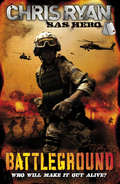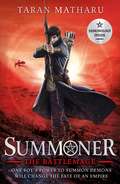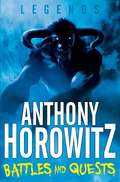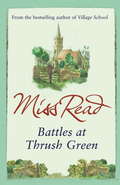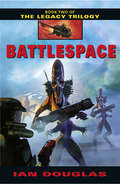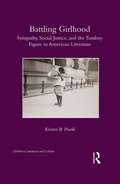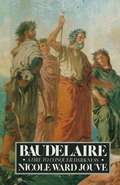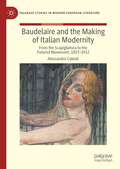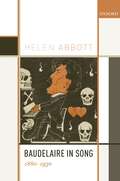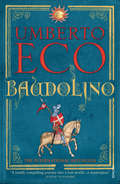- Table View
- List View
Battlefield 4: Countdown to War (Battlefield #4)
by Peter GrimsdaleThe explosive, action-packed prequel to EA's mega-selling video game, BATTLEFIELD 4.It's 3am and 20 below zero on the Chinese-North Korean border. Shanghai-based CIA operative Laszlo Kovic's mission is going straight to hell. Tasked with exfiltrating a North Korean nuclear scientist, he unwittingly leads a team of Marines into a deadly ambush. Bruised, battered and frostbitten, he returns to Shanghai seeking answers. Was he set up or did someone leak the mission? Within hours people are trying to kill him and China's own spies are after him. Against orders, Kovic assembles a crack team from Shanghai's underworld - a master hacker, a cat burglar and a former special-forces sniper. His quest takes him to the heart of a deadly conspiracy involving a sinister American-born Chinese gangster and one of the country's most revered leaders. As Shanghai descends into chaos, can he stop the plot before East and West erupt into a global war?
Battleground: Code Red
by Chris RyanYou wake up in a dark room with no idea where you are. You are gagged and forced into a waiting truck. You have done nothing wrong. What would you do? Fourteen-year-old Ben travels to Pakistan on a school exchange programme. Ben and his Pakistani host, Aaarya, find themselves in the wrong place at the wrong time. They see something they're not supposed to and are kidnapped by some strange men. Caught up in a terrifying planned terrorist attack that could destroy Southern Afghanistan, killing thousands, Ben and Aarya are dragged through the most terrifying battleground in the world.
Battlemage: Age of Darkness, Book 1 (The Age of Darkness #1)
by Stephen Aryan'I can command storms, summon fire and unmake stone,' Balfruss growled. 'It's dangerous to meddle with things you don't understand.'***Shortlisted for the David Gemmell Award***BALFRUSS is a battlemage, sworn to fight and die for a country that fears his kind.VARGUS is a common soldier - while mages shoot lightning from the walls of his city, he is down on the front line getting blood on his blade.TALANDRA is a princess and spymaster, but the war will force her to risk everything, and make the greatest sacrifice of all.Magic and mayhem collide in this explosive epic fantasy from a major new talent.For more from Stephen Aryan and the world of Battlemage, check out:Age of DarknessBattlemageBloodmageChaosmageThe Age of DreadMagebornMagefallebook-only novella: Of Gods and Men
The Battlemage: Book 3 (Summoner #3)
by Taran MatharuONE BOY'S POWER TO SUMMON DEMONS WILL CHANGE THE FATE OF AN EMPIRE ...The epic conclusion to the fantasy trilogy described as 'Harry Potter meets Lord of the Rings meets Pokemon'. After the thrilling cliffhanger at the end of book two, we rejoin Fletcher and his friends in the ether, where they must undertake a mortally dangerous quest all the while avoiding capture by enemies and facing foes more terrifying than anything they have yet encountered. But this is nothing compared to what truly lies ahead for Fletcher, as his nemesis, albino orc Khan, is on a mission to destroy Hominum and everything and everyone that Fletcher loves. Epic battles, dramatic revelations and breathtaking drama await in the third book in the New York Times bestselling Summoner series.BONUS MATERIAL: Find out more about Demons in an illustrated DEMONOLOGY - exclusive to this paperback edition.'Friendship, loyalty, magic and political intrigue beckon ...' The Bookseller
Battles and Quests (Legends #2)
by Anthony HorowitzA collection of five bite-size myths from across the globe, Battles and Quests by bestselling author Anthony Horowitz is a heartstopping retelling of some of the greatest stories ever told.Part of the Legends series of six books, Battles and Quests features the epic tales of heroes ranging from the ancient Greek myth of Theseus and the Minotaur to the Bororo Indian tale of Geriguiaguiatugo.Featuring black and white illustrations, the Legends series by Anthony Horowitz, the author of the phenomenally successful Alex Rider series, brings classic stories to life with thrilling imagination.
Battles at Thrush Green (Thrush Green #4)
by Miss ReadThe peace of the Cotswold village of Thrush Green is about to be disturbed...Children's voices ring out from the school playground; in the distance there is the gentle hum of a lawnmower; and all around the village, birdsong can be heard. But despite all evidence to the contrary, in the village of Thrush Green feelings are running high... The rector has a plan for the neglected churchyard which doesn't meet with universal approval; there is a clash of personalities at the local school; and someone has returned to the village after an absence of fifty years. Before long, the tranquillity of the Cotswold village is shattered.
Battles Lost and Won
by Beryl Matthews1919, London's East End. Robert Hunter is eagerly awaiting the return of his father from the war. Next door, Ruth Cooper's family are also preparing to welcome her dad, whose ship was lost at Jutland. After five years of separation and anxiety - and, for Bob, the worry of caring for his frail mother - emotions are running high for both young people. But Alf Hunter, who saw action in the trenches, returns a changed man, and when he takes to drink, Bob must put his own happiness on hold to support his family.
The Battles of Tolkien (Tolkien #3)
by David DayTolkien's works are punctuated by dramatic and explosive battles. Men versus Orcs, Elves versus Sauron, Goblins versus Dwarves - the history of Middle-earth has seen some of the greatest characters pitted against each other time and time again. From the iconic battle of Helm's Deep to the Destruction of Isengard, The Battles of Tolkien analyzes each battle in depth, with clear maps showing the lay of the land, and exactly how and where the armies attacked. This is essential reading for anyone who loves Tolkien's works and wants to explore the wars within them.
Battles with the Sea (Classics To Go)
by R. M. BallantyneExcerpt: "Though our foe cannot be slain, he can, like the genii of Eastern story, be baffled. In the days of old, the Storm had it nearly all his own way. Hearts, indeed, were not less brave, but munitions of war were wanting. In this matter, as in everything else, the world is better off now than it was then. Our weapons are more perfect, our engines more formidable. We can now dash at our enemy in the very heart of his own terrible strongholds; fight him where even the boldest of the ancient Vikings did not dare to venture, and rescue the prey from the very jaws of death amid the scenes of its wildest revelry."
Battlespace: Book Two Of The Legacy Trilogy (The Legacy Trilogy #2)
by Ian DouglasWhen called to do battle many light years from home, the 1st Marine Interstellar Expeditionary Unit rose to the challenge – and now thousands of enslaved humans have been freed, but the earth has moved on…
Battling Girlhood: Sympathy, Social Justice, and the Tomboy Figure in American Literature
by Kristen B. ProehlFrom Jo March of Little Women (1868) to Katniss Everdeen of The Hunger Games (2008), the American tomboy figure has evolved into an icon of modern girlhood and symbol of female empowerment. Battling Girlhood: Sympathy, Social Justice, and the Tomboy Figure in American Literature traces the development of the tomboy figure from its origins in nineteenth-century sentimental novels to twentieth- and twenty-first-century literature and film.
Battling Girlhood: Sympathy, Social Justice, and the Tomboy Figure in American Literature
by Kristen B. ProehlFrom Jo March of Little Women (1868) to Katniss Everdeen of The Hunger Games (2008), the American tomboy figure has evolved into an icon of modern girlhood and symbol of female empowerment. Battling Girlhood: Sympathy, Social Justice, and the Tomboy Figure in American Literature traces the development of the tomboy figure from its origins in nineteenth-century sentimental novels to twentieth- and twenty-first-century literature and film.
Baudelaire: Individualism, Dandyism and the Philosophy of History
by Bernard Howells"These essays take Baudelaire seriously as a thinker. Bernard Howells explores the problematics surrounding individualism and history in a number of prose texts, and situates Baudelaire within the broader contexts of nineteenth-century historical, cultural and artistic speculation, represented by Emerson, Carlyle, Joseph de Maistre, Giuseppe Ferrari and Eugene Chevreul."
Baudelaire: Individualism, Dandyism and the Philosophy of History
by Bernard Howells"These essays take Baudelaire seriously as a thinker. Bernard Howells explores the problematics surrounding individualism and history in a number of prose texts, and situates Baudelaire within the broader contexts of nineteenth-century historical, cultural and artistic speculation, represented by Emerson, Carlyle, Joseph de Maistre, Giuseppe Ferrari and Eugene Chevreul."
Baudelaire and the English Tradition (PDF)
by Patricia ClementsThis study of Baudelaire and English modernism observes his protean influence on poets from Swinburne, who wrote the first English review of Les Fleurs du Mai, to T. S. Eliot. Documenting Baudelaire's impact on Swinburne, Pater, Wilde, Arthur Symons, Aldous Huxley, Edith and Osbert Sitwell, D. H. Lawrence, the Imagists, John Middleton Murry, Eliot, and others, Patricia Clements describes the Baudelaire who is the creation of the English poets and identifies some major lines in the development of modernism in English literature.Originally published in 1986.The Princeton Legacy Library uses the latest print-on-demand technology to again make available previously out-of-print books from the distinguished backlist of Princeton University Press. These editions preserve the original texts of these important books while presenting them in durable paperback and hardcover editions. The goal of the Princeton Legacy Library is to vastly increase access to the rich scholarly heritage found in the thousands of books published by Princeton University Press since its founding in 1905.
Baudelaire and the Making of Italian Modernity: From the Scapigliatura to the Futurist Movement, 1857-1912 (Palgrave Studies in Modern European Literature)
by Alessandro CabiatiThis book establishes the role of French writer Charles Baudelaire in the formation of paradigms of modernity in Italian poetry between 1857, the year of publication of Baudelaire’s highly influential collection Les Fleurs du Mal, and 1912, when the first anthology of Futurist poetry, I poeti futuristi, was published in Milan. It focuses primarily on Baudelaire’s influence on the poetry of the Scapigliatura, a long-underrated movement which in the 1860s introduced a thematic and formal modernity into Italian literature, paving the way for Futurism and the twentieth-century avant-garde. This monograph also investigates Baudelaire’s and the Scapigliatura’s interrelated impacts on early Futurist poetry, demonstrating that Futurist poets turned to the works of Baudelaire and the Scapigliatura for inspiration on themes that were considered as distinctly unpoetic – and therefore modern – such as medical-anatomical examination, technological transformation, and abnormal sensuality.
Baudelaire in Song: 1880-1930
by Helen AbbottWhy do we find it hard to explain what happens when words are set to music? This study looks at the kind of language we use to describe word/music relations, both in the academic literature and in manuals for singers or programme notes prepared by professional musicians. Helen Abbott's critique of word/music relations interrogates overlaps emerging from a range of academic disciplines including translation theory, adaptation theory, word/music theory, as well as critical musicology, métricométrie, and cognitive neuroscience. It also draws on other resources-whether adhesion science or financial modelling-to inform a new approach to analysing song in a model proposed here as the assemblage model. The assemblage model has two key stages of analysis. The first stage examines the bonds formed between the multiple layers that make up a song setting (including metre/prosody, form/structure, sound repetition, semantics, and live performance options). The second stage considers the overall outcome of each song in terms of the intensity or stability of the words and music present in a song (accretion/dilution). Taking the work of the major nineteenth-century French poet Charles Baudelaire (1821-67) as its main impetus, the volume examines how Baudelaire's poetry has inspired composers of all genres across the globe, from the 1860s to the present day. The case studies focus on Baudelaire song sets by European composers between 1880 and 1930, specifically Maurice Rollinat, Gustave Charpentier, Alexander Gretchaninov, Louis Vierne, and Alban Berg. Using this corpus, it tests out the assemblage model to uncover what happens to Baudelaire's poetry when it is set to music. It factors in the realities of song as a live performance genre, and reveals which parameters of song emerge as standard for French text-setting, and where composers diverge in their approach.
Baudelaire in Song: 1880-1930
by Helen AbbottWhy do we find it hard to explain what happens when words are set to music? This study looks at the kind of language we use to describe word/music relations, both in the academic literature and in manuals for singers or programme notes prepared by professional musicians. Helen Abbott's critique of word/music relations interrogates overlaps emerging from a range of academic disciplines including translation theory, adaptation theory, word/music theory, as well as critical musicology, métricométrie, and cognitive neuroscience. It also draws on other resources-whether adhesion science or financial modelling-to inform a new approach to analysing song in a model proposed here as the assemblage model. The assemblage model has two key stages of analysis. The first stage examines the bonds formed between the multiple layers that make up a song setting (including metre/prosody, form/structure, sound repetition, semantics, and live performance options). The second stage considers the overall outcome of each song in terms of the intensity or stability of the words and music present in a song (accretion/dilution). Taking the work of the major nineteenth-century French poet Charles Baudelaire (1821-67) as its main impetus, the volume examines how Baudelaire's poetry has inspired composers of all genres across the globe, from the 1860s to the present day. The case studies focus on Baudelaire song sets by European composers between 1880 and 1930, specifically Maurice Rollinat, Gustave Charpentier, Alexander Gretchaninov, Louis Vierne, and Alban Berg. Using this corpus, it tests out the assemblage model to uncover what happens to Baudelaire's poetry when it is set to music. It factors in the realities of song as a live performance genre, and reveals which parameters of song emerge as standard for French text-setting, and where composers diverge in their approach.
Baudelaire's Le Spleen de Paris: Shifting Perspectives
by MariaC. ScottMaria Scott's study of the operation of irony in Baudelaire's Le Spleen de Paris contends that the principal target of the collection's spleen is its own readership. Baudelaire, as one of the most perceptive cultural commentators of the nineteenth century, was naturally very keenly aware of the growing dominance of the bourgeoisie in France, not least as a market for art and literature. Despite being dependent on this market for his own writing, the poet was highly critical of bourgeois values and attitudes. Scott builds on existing criticism of the collection to argue that these are indirectly mocked in Le Spleen de Paris, often in the person of the poet's supposed textual alter ego. The contention is that the prose poems betray the trust of readers by way of an apparent transparency of meaning that functions to blind us to their embedded irony. Though focused on Le Spleen de Paris, Scott's study engages with the full range of Baudelaire's writings, including his art and literary criticism. Her book will be of interest not only to Baudelaire scholars but also to those engaged more generally with nineteenth-century French culture.
Baudelaire's Le Spleen de Paris: Shifting Perspectives
by MariaC. ScottMaria Scott's study of the operation of irony in Baudelaire's Le Spleen de Paris contends that the principal target of the collection's spleen is its own readership. Baudelaire, as one of the most perceptive cultural commentators of the nineteenth century, was naturally very keenly aware of the growing dominance of the bourgeoisie in France, not least as a market for art and literature. Despite being dependent on this market for his own writing, the poet was highly critical of bourgeois values and attitudes. Scott builds on existing criticism of the collection to argue that these are indirectly mocked in Le Spleen de Paris, often in the person of the poet's supposed textual alter ego. The contention is that the prose poems betray the trust of readers by way of an apparent transparency of meaning that functions to blind us to their embedded irony. Though focused on Le Spleen de Paris, Scott's study engages with the full range of Baudelaire's writings, including his art and literary criticism. Her book will be of interest not only to Baudelaire scholars but also to those engaged more generally with nineteenth-century French culture.
Baudelaire's Media Aesthetics: The Gaze of the Flâneur and 19th-Century Media
by Marit GrøttaBaudelaire's Media Aesthetics situates Charles Baudelaire in the midst of 19th-century media culture. It offers a thorough study of the role of newspapers, photography, and precinematic devices in Baudelaire's writings, while also discussing the cultural history of these media generally. The book reveals that Baudelaire was not merely inspired by the new media, but that he played with them, using them as frames of perception and ways of experiencing the world. His writings demonstrate how different media respond to one another and how the conventions of one medium can be paraphrased in another medium. Accordingly, Baudelaire's Media Aesthetics argues that Baudelaire should be seen merely as an advocate of "pure poetry,†? but as a poet in a media saturated environment. It shows that mediation, montage, and movement are features that are central to Baudelaire's aesthetics and that his modernist aesthetics can be conceived of, to a large degree, as a media aesthetics.Highlighting Baudelaire's interaction with the media of his age, Baudelaire's Media Aesthetics discusses the ways in which we respond to new media technology, drawing on perspectives from Walter Benjamin and Giorgio Agamben. Combining detailed research with contemporary theory, the book opens up new perspectives on Baudelaire's writings, the figure of the flâneur, and modernist aesthetics.
Baudelaire's Media Aesthetics: The Gaze of the Flâneur and 19th-Century Media
by Marit GrøttaBaudelaire's Media Aesthetics situates Charles Baudelaire in the midst of 19th-century media culture. It offers a thorough study of the role of newspapers, photography, and precinematic devices in Baudelaire's writings, while also discussing the cultural history of these media generally. The book reveals that Baudelaire was not merely inspired by the new media, but that he played with them, using them as frames of perception and ways of experiencing the world. His writings demonstrate how different media respond to one another and how the conventions of one medium can be paraphrased in another medium. Accordingly, Baudelaire's Media Aesthetics argues that Baudelaire should be seen merely as an advocate of “pure poetry,” but as a poet in a media saturated environment. It shows that mediation, montage, and movement are features that are central to Baudelaire's aesthetics and that his modernist aesthetics can be conceived of, to a large degree, as a media aesthetics.Highlighting Baudelaire's interaction with the media of his age, Baudelaire's Media Aesthetics discusses the ways in which we respond to new media technology, drawing on perspectives from Walter Benjamin and Giorgio Agamben. Combining detailed research with contemporary theory, the book opens up new perspectives on Baudelaire's writings, the figure of the flâneur, and modernist aesthetics.
Baudolino (Booket/columna Ser. #Vol. 28)
by Umberto EcoAn extraordinary epic, brilliantly-imagined, new novel from a world-class writer and author of The Name of the Rose. Discover the Middle Ages with Baudolino - a wondrous, dazzling, beguiling tale of history, myth and invention. It is 1204, and Constantinople is being sacked and burned by the knights of the fourth Crusade. Amid the carnage and confusion Baudolino saves a Byzantine historian and high court official from certain death at the hands of the crusading warriors, and proceeds to tell his own fantastical story.
Baudrillard Now: Current Perspectives in Baudrillard Studies (Theory Now)
by Ryan BishopThe writings of Jean Baudrillard have dramatically altered the face of critical theory and promise to pose challenges well into the 21st century. His work on simulation, media, the status of the image, the system of objects, hyperreality, and information technology continues to influence intellectual work in a diverse set of fields. This volume uniquely provides overviews of Baudrillards career while also simultaneously including examples of current works on and with Baudrillard that engage some of the many and varied ways Baudrillard's work is being addressed, deployed, and critiqued in the present. As such, it offers chapters useful to the novice and the well-versed in critical theory and Baudrillard Studies alike. Contributors to the volume include John Armitage, John Beck, Ryan Bishop, Doug Kellner, John Phillips and Mark Poster. No less controversial today than he was in the past, Baudrillard continues to divide intellectuals and academicians, an issue this volume addresses by re-engaging the writing itself without falling into either simplistic dismissal or solipsistic cheerleading, but rather by taking the fecundity operative in the thought and meeting its consistent challenge. Baudrillard Now provokes sustained interaction with one of philosophy?s most important, provocative and stimulating thinkers.

